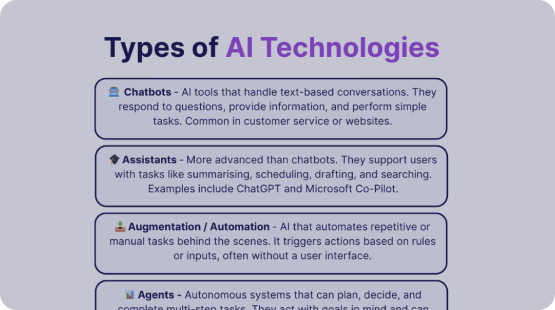5 Kinds of AI Every Workforce Leader Should Understand
Blog Post Body
Table of Contents
Talk to a Work Strategist
See the Work Operating System in action and start re-engineering work for AI.
Subscribe to our newsletter
The latest insights on re-engineering work for AI
Everyone’s talking about AI. Most people still don’t know what they’re talking about.
You hear chatbots, agents, automation, machine learning, robotics and it all starts to blur.
But if you’re leading your organization into the future of work, you need to know what these tools are, how they work, and the impact they actually have. Some will assist your people. Some will augment them. Others will replace entire workflows.
If you understand the type of AI you're working with, you can design your workforce strategy with clarity and confidence.
AI isn’t one thing. It’s a spectrum.
It’s not about job loss. It’s about task shift.
Most AI today works at the sub-task level. It’s not taking your whole job. It’s taking little pieces — summarizing a document, generating a draft, recommending next steps.
That’s the now. But where we’re going? That’s where things get interesting.
1. Chatbots – assist with repetitive conversations
These are scripted tools that handle text-based queries.
They respond to questions, provide simple information, and route people to answers.
You’ve seen them in HR, IT, and customer service.
🛠️ Used for: FAQs and common queries
❌ Doesn’t: Solve complex problems
📉 Impact: Low – reduces noise, but doesn’t change workflows
2. Assistants – support tasks like summarizing and drafting
These tools are more advanced than chatbots.
They support users with sub-tasks — summarizing, drafting, searching, and scheduling.
Examples include ChatGPT and Microsoft Co-Pilot.
🛠️ Used for: Knowledge work at the sub-task level
✅ Strength: Speeds up work, helps generate outputs
⚙️ Impact: Medium – improves productivity, doesn’t operate alone
3. Augmentation / Automation – execute repetitive or manual tasks
This is AI that runs behind the scenes.
It triggers actions based on inputs or rules — no user needed.
Think of RPA, task triggers, and system-level automations.
🛠️ Used for: Routine, rules-based processes
✅ Strength: Consistent and fast
⚙️ Impact: Medium – replaces repetitive steps, not entire roles
4. Agents – plan,decide, and act across systems
These are autonomous systems that handle multi-step tasks with a goal in mind.
They coordinate across tools, take initiative, and adapt to context.
An agent could extract data, make a decision, and notify the right person — without input.
🛠️ Used for: End-to-end workflows across platforms
✅ Strength: Acts with intent and context
🚀 Impact: High – reshapes how work flows through systems
5. Robotics – perform physical tasks in the real world
Machines that use AI to move, lift, package, and assemble.
Robots have long supported physical labor. Now they’re part of digital systems too.
Dark factories and automated warehouses show where this is heading.
🛠️ Used for: Manufacturing, logistics, and healthcare
✅ Strength: Fast, safe, precise
🏭 Impact: Massive – transforms how physical work gets done
Why this matters
If you don’t know what kind of AI you’re dealing with, you risk two things: overreacting or missing the moment.
Most work won’t disappear overnight. It’ll be rearranged — as tasks shift between humans, agents, and automations.
Your role is to decide:
- What stays with people
- What shifts to digital workers
- How to match the right tech to the right kind of work
That’s how you reduce waste, protect potential, and build better.
Your next step: Audit your world.
What AI is already in your business?
- What’s just a chatbot?
- What’s true automation?
- Where are agents emerging — and where could you build one?
We’re working on something for leaders that helps ask these questions.
If you like content like this — clear, tactical, built for people who design work — you’ll want to see what’s coming.
➡️ Subscribe to the Reejig newsletter to get first access.
No noise. Just what matters to build the AI-powered workforce — the right way.
Siobhan 💜
Talk to a Work Strategist
See the Work Operating System in action and start re-engineering work for AI.
Subscribe to our newsletter
The latest insights on re-engineering work for AI


